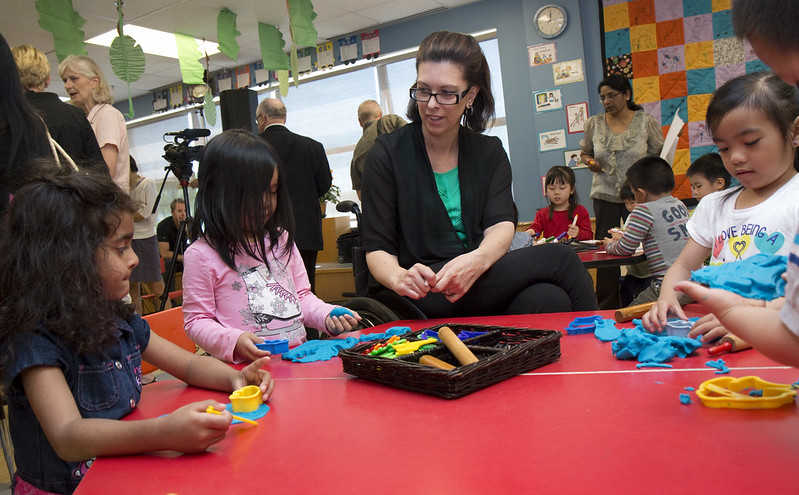Two million fewer women are working outside of the home than last year, mostly due to caregiving needs. Congress can provide the long-overdue help that families need.

The United States is on the cusp of transformative change for America’s families. The Build Back Better Agenda, currently being negotiated in Congress, would create the nation’s first-ever paid family and medical leave program; make affordable, high-quality childcare and pre-kindergarten available for children and families; and raise wages for childcare workers.
For too long, American families—women in particular—have been forced to balance work and caregiving needs. We now have a once-in-a-generation opportunity to boost the economic well-being of women and children and take steps toward a more inclusive economy, reducing racial and gender inequities.
The COVID-19 Pandemic Didn’t Create America’s Care Crisis
The COVID-19 pandemic exacerbated America’s care crisis but didn’t create it. Ask any parent who has searched for childcare and they will describe limited options, high costs and long waiting lists. The U.S. Treasury Department recently called the nation’s childcare system “unworkable.” The market failures in childcare result in high costs for parents and poverty wages for childcare workers.
It’s not just childcare that is unworkable. For millions of workers, a family member’s illness or the birth of a child can trigger income and job loss simply because they do not have paid leave from their job. Nearly one in four employed mothers return to work within two weeks of giving birth. Families lose an estimated $22.5 billion dollars annually due to inadequate paid leave.
While the challenges of care are universal for most families, the impacts are not borne equally. For the lowest-income families, childcare can consume 30 percent of their household budget, over three times that of higher-income families. Black and Latinx workers are less likely to have paid leave than their white counterparts, and these benefits are virtually nonexistent among the low-wage workforce, who are disproportionately women. When caregiving needs arise, these workers face impossible choices between caring for themselves or loved ones and putting food on the table or making rent.
The consequences of these impossible choices go well beyond household economics. When childcare is unavailable or unaffordable, parents may use unstable or lower-quality care that fails to support kids’ learning and development. Lack of paid leave also means insufficient time to recover from a birth or access treatment for an illness.
Here’s What’s at Stake Today
Today, two million fewer women are working outside of the home, compared to a year ago, primarily due to caregiving needs. More than 100,000 childcare programs have closed permanently because of the pandemic. As the pandemic continues, people continue to fall ill and need care or must quarantine to keep others safe.
Centuries of structural racism mean that unemployment rates remain elevated for Black and Latina women, who are most likely to be primary or sole breadwinners for their families. Experts predict it’ll take nearly a decade for women to recover from pandemic-related job losses.
Given how much is at stake—the health and well-being of children and families—it’s hard to believe lawmakers have failed for decades to address the immense challenges facing working families. It’s been more than 25 years since Congress passed the Family and Medical Leave Act (FMLA) that provides unpaid family and medical leave to eligible workers. But over 60 percent of workers earning low wages aren’t even eligible for FMLA—and even if they were, unpaid leave isn’t an option for those living at the edges of financial stability.
It’s been twice as long since Congress passed a universal childcare bill in 1971, only to be vetoed by President Nixon. No childcare solution that would meet the need has been considered since. The public programs that do exist suffer from chronic underfunding—the primary federal program to help families with childcare costs, for instance, reaches only one in seven eligible children due to insufficient funding.
America Could Turn the Tide on Its Shameful Neglect of Working Families
Right now, the U.S. House and Senate are working feverishly to pass the Build Back Better Act—a package of policies proposed by the Biden administration that would make sweeping changes for families. It would create our first-ever national paid family and medical leave program, and guarantee all families access to affordable, high-quality childcare for young children and universal pre-kindergarten for 3- and 4-year-olds.

A 10-year federal investment of $450 billion in childcare and pre-kindergarten would reach more than 8 million young children annually. That’s 11 times more than those served without expansion. Families would see child care costs capped—ensuring they pay no more than 7 percent of their income—and the lowest income families would pay nothing at all. Pre-kindergarten would be available to all 3- and 4-year-old children so they are ready to succeed in school and in life. Decades of research demonstrate that high-quality childcare and early education can improve children’s educational and employment experiences into adulthood—all while allowing parents to reenter the workforce.
In addition, all workers would have up to 12 weeks to care for a new child, a family member or themselves with a progressive wage replacement rate to keep their families economically secure. A national paid leave program would ensure no one has to miss a baby’s first smile or is unable to hold their dying parent’s hand to avoid losing a job or falling behind on bills. Nine states and the District of Columbia have passed family and medical leave programs, showing this policy is practical and possible.
These measures pay off for our economy—keeping workers employed, increasing earnings and productivity, and investing in our next generation. Congress has a powerful opportunity to advance racial and gender equity. Most crucially, these investments provide the long-overdue help that families need.
Up next:





